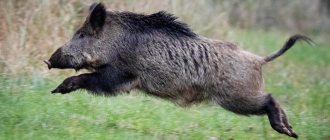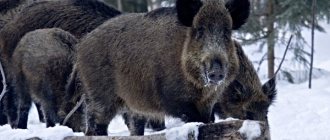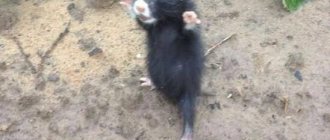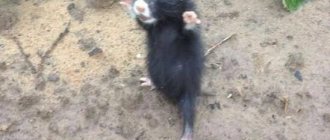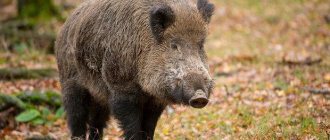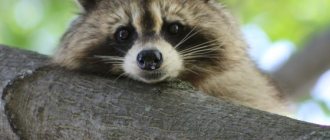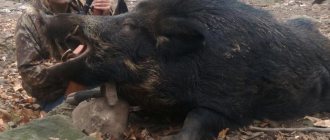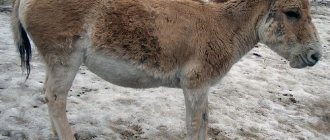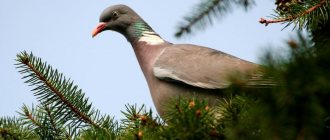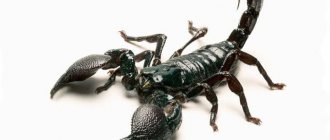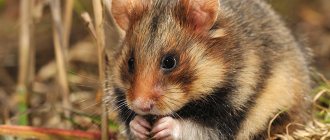The boar cleaver is the most famous and popular animal among hunting enthusiasts. A trophy in the form of a head or fangs, hanging on the wall after a successful hunt, pleasantly pleases the eye and adds its own zest to the home interior.
But you need to remember that hunting boar is very dangerous. If the shot is unsuccessful (especially for inexperienced hunters), he can only be wounded. This causes the boar to become enraged; it can attack the hunter and cause serious injury to him.
Appearance
What does a boar look like? The boar is a powerful and strong animal. He has a fairly large build and short legs. A short body with a short tail, a massive sternum and a narrow pelvis. His neck is short, thick, and his skull is wedge-shaped. The nose of a boar, like that of a domestic pig, is snout-shaped.
The coat is hard and resembles bristles. It ranges from dark gray to brown. With the arrival of winter, it thickens and a dense undercoat appears.
The cleaver has a body with a length of 90-180 cm. Its height at the withers varies from 50 to 110 cm. How much does a boar weigh? It weighs from 50 to 300 kg. The average weight of a boar is 150 kg. The male boar is usually larger and heavier than the female. The maximum speed of the boar is up to 45 km per hour.
How long do wild boars live? The average life expectancy is approximately 10 years, and in captivity – up to 20 years.
The most notable part of the cleaver's body is its fangs. When the boar reaches maturity, they grow up to 25 cm. With them, he obtains food for himself, digging up the ground to extract rhizomes. Cleavers also use their fangs to defend themselves from enemies: bears or wolves.
How fast does a boar run?
Each animal has its own running speed. Which one of them runs the fastest? We present to your attention the top 20 fastest animals in the world.
Table of maximum speeds of animals
| Animal | Max speed (km/h) |
| Cheetah | 140-148 |
| Antelope | 120 |
| Jaguar | 90 |
| Tiger | 80 |
| Puma | 80 |
| Hare | 80 |
| Elk | 72 |
| Ostrich | 70 |
| Russian greyhound | 70 |
| Dogs | 67 |
| Camel | 65 |
| Wolf | 56-64 |
| Roe | 60 |
| Lynx | 40-60 |
| Bear | 30-60 |
| Cats | 58 |
| Rabbits | 56 |
| Giraffe | 55 |
| a lion | 52 |
| Gorilla | 180 |
| Fox | 50 |
| Boars | 40-50 |
| Deer | 48 |
| Rhinoceros | 48 |
| Hippopotamus | 48 |
| Crocodile | 40 swim |
| Elephant | 35-40 |
| Cow | 30-40 |
| Turtle | 35 swim |
| Husky | 35 |
| Varan | 10 |
| Hedgehog | 10 |
| Rat and mouse | 10 |
Additional edits will be made over time
- The Mongolian kulan opens the list of twenty fastest animals. This endangered species of kulan lives in East Asia, on the border of Mongolia and Northern China. It accelerates up to 64 km/h.
- The black and white striped zebra serves as an inspiration not only for fashionistas and art critics, but even for athletes. So, they decided to paint the South African Mbombela stadium in these colors. A zebra's running speed is 64 km/h.
- It has long been known that hyenas can produce sounds that resemble giggling and laughter. Although this does not mean that they are funny and cute animals. These natural predators have powerful jaws. They run up to 64 km/h.
- Thomson's gazelle was named after Joseph Thomson, who was a Scottish geologist and explorer. This is one of the most widespread subspecies, which numbers more than 500 thousand individuals. Their main habitat is the expanses of the Serengeti. Thomson's gazelle can run at a speed of 65 km/h.
- The gray fox was considered the most primitive species of the canine family. But now it is a rare species, due to the ruthless hunting for its skin. The gray fox runs at a speed of 67.5 km/h. She can also climb trees, escaping from larger predators.
- The greyhound is another domesticated animal on our list. Previously, this dog breed was bred mainly for racing, although recently it has become popular as a pet. The running speed of a greyhound is 69 km/h, and it reaches this speed in just 30 minutes, and it accelerates to 32 km/h after only 250 m. This is the second animal on the planet that accelerates at such a pace over short distances.
- The onager is also a representative of the equidae. This is a desert inhabitant that runs at a speed of 69 km/h.
- The coyote, or as it is also called the American jackal, is capable of running at speeds of up to 69 km/h and eats absolutely everything that comes in its way - be it insects or people's pets.
- The title of the fastest and largest bird on the planet belongs to the ostrich, accelerating up to 70 km/h.
- The red kangaroo jumps at speeds of up to 71 km/h and maintains this pace over a distance of up to 2 km. The more he jumps, the less energy he uses.
- Wild dogs, of course, look like hyenas, but still they are not hyenas. The wild dog goes by many names, but the essence does not change - these animals run at a speed of 72 km/h.
- The wapiti is the second largest deer in the world, capable of speeding up to 72 km/h.
- Speaking about the black-tailed hare, I remember the fairy tale about the hare and the tortoise. And even if this is only a fairy tale, there is some truth in it. This little animal can run at a speed of 72 km/h and jump up to 3 m in height.
- The lion is a regal cat that is considered the second largest of its kind and can reach speeds of up to 80 km/h.
- The Indian antelope is listed as an endangered species by the International Union for Conservation of Nature. This antelope accelerates to 80 km/h, thus escaping from a wild cat and a wolf.
- Although wildebeests have a large and clumsy appearance, they run at speeds of up to 80 km/h.
- If a racehorse is well trained, it will accelerate to 88 km/h.
- And the top three is opened by a small antelope - the springbok, whose running speed is 100 km/h.
- Silver medalist – pronghorn antelope. According to some reports, she reaches a running speed of at least 98 km/h, although there are reasonable assumptions that this is far from her maximum speed. At the same time, it is worth noting that there are no more accurate measurements of this indicator characteristic of the pronghorn antelope.
- And at the top of this parade of the fastest animals in the world is the cheetah, which bears the title of the fastest land representative of the animal world. He can run at speeds of up to 140-148 km/h. It can maintain this speed at a distance of up to 500 m, accelerating from 0 to 100 km/h in just 5 seconds. (this figure exceeds most sports cars).
Everyone knows that the fastest animal on earth is the cheetah. Although, it’s worth slightly correcting this sentence - the fastest is only on land. If we were to make a “general animal” rating, including at least only birds of prey, the cheetah would hardly be able to even be in the top ten.
- October 26, 2019
- Miscellaneous
- Danil Sharov
The wild boar is a relative of the domestic pig. The wild animal differs from the domestic pig in its thick and short body, strong and fairly high limbs, elongated and narrower head, and sharp ears. Wild boars live in herds in which females are in charge. Typically, a group can contain from 10 to 30 animals. However, herds of up to hundreds of individuals have been observed.
The distribution area of wild boars is extremely wide. In the wild, they are found throughout almost all of Europe, many regions of Asia and northern Africa. Domesticated boars live on every continent except Antarctica. Let's get acquainted with the characteristics of these animals.
Habitat
Where does the wild boar live? Initially, these animals were seen in the countries of Asia, Europe, and North Africa. Afterwards they appeared on the islands of Britain, Java, Sumatra and many others. Today they live in the forests of Siberia, in some areas of the Irkutsk region, as well as the Krasnoyarsk Territory. You can also meet him in the Moscow region.
The boar's habitat is tropical, mountain forests with high humidity. In our country, it is attracted to oak forests and marshy areas.
Top 10 fastest land animals
Who is the fastest in the world? Who is capable of covering more than a hundred kilometers in an hour or accelerating to a hundred in a couple of seconds? Speed records for four-legged animals are in our ranking.
10. Moose
The northernmost of the top 10 runners is elk. The largest of the reindeer (up to 650 kg), the symbol of almost all northern countries is also a noble runner. Running 60 in an hour is quite an achievable result for an elk. Due to the speed of movement and the ability to defend itself with blows from its front cloven hooves, the elk has few natural enemies. Only bears manage to cope with horned giants. Wolves are content with very young or, conversely, old and sick moose. Moose pose virtually no danger to humans. Just to avoid meeting him on the road, when a moose, hit by a speeding car, flies into the cabin in its entirety.
9. wild dog
When you come across the name Cape Hunting Dog, do not translate it directly. This is a hyena-like dog. Distributed throughout Africa from the southern borders of the Sahara to the very south, this canid animal can run at a speed of 70 km/hour. Dogs hunt in packs. One clings to the victim's tail, the other to the upper lip, and the rest tear the prey apart. If a specific “ho-ho” is heard in the area, it means that the dogs have gathered for prey, beware, animals! Even zebras and wildebeest may have trouble.
8. Horse
As you know, there are many breeds of horses. Some are famous for their strength, some for their speed, some stand out for their endurance, “high altitude”, and a combination of several qualities. Purebred English horses are considered the fastest. But horse speed records have been recorded for short distance running. The maximum speed of 77 km/h was recorded at a distance of a quarter mile. Horses of a special breed bred for such races are called “quarter-mile”, in English `quarterhorse`.
5-7. a lion
That’s why he is the king of beasts, so that he can be distinguished not only by his power, but also by his speed. With power, everything is clear: the second heaviest “cat” (after the tiger) weighs up to 250 kg, and in the UK, the lion Simba, who lived in the zoo, weighed up to 375 kg. The speed of movement is also quite decent - up to 80 kilometers per hour. So the kinetic energy of a running lion is truly royal and will not yield to anyone!
5-7. wildebeest
The wildebeest is an African resident. Hefty horned animals reach a weight of 250 kg. They can run at speeds of up to 80 km/h. Imagine a herd of 500 wildebeest, rushing at a “cruising speed” of 55 kilometers per hour! Now imagine what will happen to some field when such a team walks across it. With equal speed and almost equal mass, wildebeest are the favorite food of lions. The predator wins due to intelligence: it hunts from ambush and uses a powerful jump.
5-7. Thomson's Gazelle
These relatively small (weight - 28 kg) gazelles live in Kenya and Tanzania. It was named after the Scottish explorer of Africa Joseph Thomson. The main "fan" of Thomson's gazelles is the cheetah. Since the speed of gazelles is significantly lower, 80 km/h, their stayer running helps them out: a cheetah sprinter quickly “runs out of steam,” and Thomson’s gazelles are natural stayers, maintaining speed over long distances.
4. Pronghorn
Pronghorns inhabit the steppes of North America. Now they are the only representatives of the once widespread family of pronghorns. Their speed record is 88.5 km/h. But they can only withstand this speed for 5-6 kilometers. The normal running speed of pronghorns is half that.
2-3. Garna
This Asian animal is also called the horned antelope and the deer antelope. Garna, a member of the bovid family, lives in India, Pakistan, Bangladesh and even in the highlands of Nepal. The running speed of the garn is up to 96 kilometers per hour.
Lifestyle
This animal does not have very good eyesight, but has an excellent sense of smell. It can smell a person, especially downwind, at a distance of about 400 km. Strong odors can scare away the animal and disrupt the hunt.
The boar is an animal that lives primarily in herds. Usually it is inhabited by females with wild boars from last year's hatch. An adult boar leaves it and lives alone. He returns to the herd only for the mating period, taking the place of the leader.
The boar is active at night. During this period, he goes out to have lunch and take water treatments. During the day, he rests in the reeds or in the swamps, hiding in the bushes.
How fast do wild boars usually move?
In everyday life, boars mainly walk or jog. Their speed is comparable to the speed of a walking person: 2−5 km/h.
The boar generally starts running if it is in danger. Since these animals are omnivores, and their predatory nature does not prevail, they are accustomed to fleeing from danger rather than engaging in battle. For hunting, wild boars rarely use fast running, preferring to eat roots or grass.
On a note! Boars usually develop high speed when fleeing from danger.
However, there are species that are more predatory in nature. These are warthogs. The structure of their body allows them to be more active, move long distances and develop good speed. They often hunt small and medium-sized herbivores. For them, the average speed of movement is 5-8 km/h; when hunting or in danger, they can accelerate 5 times more.
Habits
The habits of a wild boar are quite interesting.
These animals are very sensitive to temperature changes. To avoid sunburn and to protect themselves from various insect bites, they are thoroughly smeared in mud.
An important condition for these animals to live is the presence of a body of water near the rookery.
The habits of wild animals force the boar to stay away from people. They approach populated areas extremely rarely, but forays into fields where oats or corn grow are made regularly.
The boar leads a sedentary lifestyle. During the summer months, it only emerges from its hiding place to feed. Then he comes back again to rest.
In winter, the wild boar's habits do not change. The wild boar also moves little in winter, since the snow does not allow it to go far. The wild boar, despite its clumsiness, is an excellent swimmer.
Ostrich
Ostriches' long legs are composed mainly of tendons, which allow them to maintain high speeds over long distances. His legs work almost like a pogo stick - a jumping device consisting of a spring, a handle, pedals and a main platform. Once the bird gains speed, this springing action lifts its foot off the ground with each step, allowing it to maintain momentum. Their maximum speed is about 80 km/h, and their cruising speed is up to 50 m/h. The undisputed leader of our marathon race with a result of 40 minutes.
Gon
The rutting period for wild boars lasts from December to January. An adult male finds a herd of females by smell, sound and tracks. When the wild boars are in season, they return to the herd. After fertilization they leave it again. As a rule, wild boars have several females during the rut.
At this time, the behavior of males becomes aggressive. If a rival comes into the herd, a fight to the death is inevitable. They hit each other with their fangs, causing terrible lacerations. The loser leaves the herd.
The female's pregnancy lasts 120-130 days. Before giving birth, she leaves the herd and looks for a secluded place. Then he builds himself a bed, like a “nest” from branches and dry grass.
A female boar gives birth to 5 to 15 piglets, weighing about 1 kg. Their fur is black or brown with white longitudinal stripes. This color protects babies from attacks by predators. It is better not to approach the female’s den during this period, as she is very aggressive.
Camel
Unlike the city marathon, there are no checkpoints in the desert where you can replenish your body's water reserves. Nevertheless, the camel is not discouraged, because evolution has endowed it with special tools, thanks to which it stores fat. In addition, camels lower their body temperature in the morning, which increases their endurance throughout the day. All this allows them to run the classic marathon distance in 1 hour and 2 minutes at an average speed of 40 km/h. The maximum speed of a camel is about 65 km/h. And note, all this under the scorching sun!
Nutrition
What do wild boars eat? The appearance of these animals is quite formidable, so many are interested in whether the wild boar is a predator or not.
In fact, they are practically omnivorous, because wild boars eat different foods at different times of the year:
- The wild boar feeds in the forest, extracting various roots and tubers of bulbous plants from underground. They contain a large amount of useful substances.
- In summer and spring, wild boar feed on green leaves and shoots of plants.
- Its diet includes berries, fruits, acorns, nuts, potatoes and agricultural plants.
- They also feed on frogs, earthworms, insects, larvae, and small vertebrates, and in winter they do not hesitate to pick up carrion.
- In the fall, wild boar also eat acorns, voles, oats and wheat.
Now you know what a wild boar eats.
Boar speed when running Km h
Overtake the mark (in the direction of movement of the animal) to the slaughter place and press the trigger. He (the beast) falls. In addition, there are no vertical errors with this type of aiming. They are excluded by technology. I repeat once again: by and large, there is no difference between shooting at a flying bird and shooting at a running animal. The shooting techniques are absolutely the same. And the most effective technique is CROSSOUT.
Well, and so on. And if I can get where I want to go, then why shouldn’t others be able to do it? By the way, I also shoot at a stationary animal by moving the carbine horizontally. Only the finger presses the trigger BEFORE the stamp hits the killer spot.
FIGHTER'S ADVICE: There is a very simple method to expel Doubting Thomas from yourself and quite quickly master the technique of shooting at a moving target. Maybe someone will find this useful:
Tie a long double rope (so that the tire does not rotate around a vertical axis) to something high. car tire. Place several stones inside it (for weight). Cover the hole from the steering wheel with cardboard and glue a bright circle with a diameter of 150 mm in the center. And then everything is simple. This miracle pendulum is swinging. He swings for quite a long time, so that there is more than enough time to move away 50 meters (you should start with this pioneer distance) and start exercising. And the “lush green tree of life” will immediately tell you the speed of the leash you need, and the time to press the trigger, and. answers to many questions that may arise. This simulator is primitive, but it is very good because it can be built anywhere (of course, in a deserted place, so that the bullets go into a slope, into a steep bank, etc.) SAFETY PRECAUTIONS MUST BE COMPLIED.
I don't believe it won't work!
So RUSS71, your calculations are correct if you shoot at a point, without a leash.
Although, as colleagues correctly noted, the methods may be different.
There is such a miracle as a ballistic calculator. So we enter your data there, or rather what we have, and we get that at a speed of 800 m/s, with a Norma Orix 13gr bullet, when shooting at 200 m at a running boar whose speed is 50 km/h, the lead should be 4 meters! Since 10 m/s is 36 km/h, we get that in your case it is almost 3 m.
So RUSS71, your calculations are correct if you shoot at a point, without a leash.
Although, as colleagues correctly noted, the methods may be different.
I agree. There’s simply no time on a leash. He runs quite quickly, and sometimes you don’t even have time to raise your gun in just a second and you’re gone. If the terrain allows, choose an intersection point (let’s say a tree, a bush) and time the shot.
Forget about all sorts of calculators. For animal hunting, this approach is unrealistic. A calculator is only for the shooting range, shooting on a hunt is just practice and more practice and, of course, luck.
So RUSS71, your calculations are correct if you shoot at a point, without a leash.
Although, as colleagues correctly noted, the methods may be different.
I have nothing against shooting offhand without a leash (for a certain type of target), when hunting, I shoot birds from under the dog, shooting at the target simultaneously with the insert of the gun. But let me express serious doubts about the effectiveness of this method on side targets. Let’s say you jump up to the expected lead point at 2 and someone says at 3, the first question is how do you determine this point, carry a bk with you, or empirically. The second question is how to get to this point not with the strap of a shotgun (where an error in cm in the accuracy of a bird shot at 30m means nothing) but with an optic crosshair (in my case 6 times)) at a long distance where such an error can take the bullet meters away. Try to do a simple but very useful exercise at home with a shotgun: stick several circles the size of a two-ruble coin on the wall, and throw yourself into them, trying to immediately see only the front sight and the target when inserting. I’m not sure what will happen without constant training, at least in 70 percent of such jumps , and every shot will require micro-adjustment of the sight, and this is the time during which the target travels some distance. Now do this exercise in the field with a carbine with optics against targets the size of a watermelon at 200m, I think it will take much more time to adjust the sight. Now the question of when to shoot, when underlining is clear when overtaking, when on a leash is also clear when equalizing speeds with lead adjustment. When shooting offhand, they shoot at the moment of the insertion, that is, you must immediately hit this (it is unknown how the calculated point) absolutely accurately and shoot right away. It's probably a little difficult for me. Further, the vertical error, I completely agree with the fighter, when emphasizing in a person with normal coordination, it is practically eliminated; it is easier to coordinate with a short tempo movement than with a long leash. You can shoot at side targets with a standing barrel, but it’s not very good to hit, a standing barrel in this case will miss (usually from behind).
Natural enemies
Boars have their enemies. These are wolves, bears or lynx. Wolves attack in packs. First, one of them, jumping on top of the boar, throws it to the ground, then the whole flock attacks him. Lynx most often attacks young individuals that have strayed from the herd. She jumps on his back, inflicting severe and fatal wounds.
The bear is the most terrible enemy. Attacking the cleaver, the bear squeezes the animal with its powerful paws, and it dies from broken bones.
Horse
Yes, horses are the slowest marathon runners in our selection. These mammals are capable of reaching speeds of up to 90 km/h on average, while at a distance of more than 30 km the average speed drops to 16-17 km/h, and they run a standard marathon of 42 kilometers and 195 meters in 2.5 hours. Over years of selective breeding, racehorses have developed a built-in biological mechanism for efficient circulation. When they start running, their spleen releases a whole bunch of red blood cells to increase the oxygen content of their blood. The British town of Llanwrtyd Wells hosts two annual competitions: bog diving and the 35-kilometer Man vs. Horse race. Humans have won the race only twice, but the best runners were only 10 minutes slower than the powerful equid. The equine hematopoietic system is more efficient than the human one, but humans have a more advanced thermoregulation system. In addition, they do not run with a rider on their back.
Features of hunting
Hunting wild boar is one of the most dangerous activities. You can hunt alone or take part in a hunt. We must not forget about the peculiarities of the habits of wild animals and the fact that he is very large. Its weight reaches 300 kg.
The beginning of the hunting season depends on the places where it lives. From August to January there is hunting for young animals and males. Shooting of females occurs in September and December. You can hunt for cleavers in different ways: from a tower, a pen, with dogs or from the approach.
The fastest animals (land animals) in the world
Which animal is the fastest in the world? Who can only overtake a cyclist, and who can only overtake a racing car? Who is faster, predator or prey? What is the maximum speed of animals and who has it? Interesting? Then read on!
1. The absolute record holder among animals for the speed of their movement is the cheetah (Acinonyx jubatus). This beast is capable of running at a speed of about 100 km/h, accelerating to its maximum speed in 3 seconds. With such indicators, cheetahs can overtake even a good car if they race the car for a short distance. Cheetahs cannot maintain high speeds for a long time - this is deadly for their body.
2. Pronghorn (Antilocapra americana) usually runs at a speed of no more than 50 km/h, but when in danger it accelerates to 67-70 km/h. And she took second place in the ranking, thanks to a speed record of 88.5 km/h.
3. Grant's gazelle (Gazella granti) lost second place to the pronghorn only because it does not have an officially documented speed record. Or it could get ahead of its competitor, because Grant’s gazelle is supposedly capable of running at a speed of 80-90 km/h.
Interesting Facts
- Boars are among the ten most intelligent animals; they are very smart and observant.
- Boars' sense of smell is better developed than that of dogs: they can easily find food in the ground by smell. Noticing this feature, people taught wild boars to look for truffles - the most expensive mushrooms in the world, growing at a depth of 30 cm and below.
- Boars constantly sharpen their upper and lower tusks by rubbing them against each other.
- The wild hog is one of the first domesticated animals. It is known that the ancestors of modern pigs were domesticated by humans more than 10 thousand years ago in Asia.
- Boars and pigs are unreasonably called dirty: these animals are very clean, and traditional water and mud baths are just a way to get rid of parasites and cleanse stubble.
Where does it live?
Indian
The historical range extends to Europe, the Middle East, India, most of the Asian continent, and northern Africa. Wild boars, which are found in America and Australia, are the feral ancestors of domestic pigs brought there by colonists.
Where does he live?
The traditional habitat of the wild boar is deciduous and mixed forests. The crowns of trees and shrubs that descend to the ground provide shelter for the animal and also provide food. You can meet a wild boar near rivers and swamps, where it hides in reed thickets. Wild boars also live in mountainous regions.
